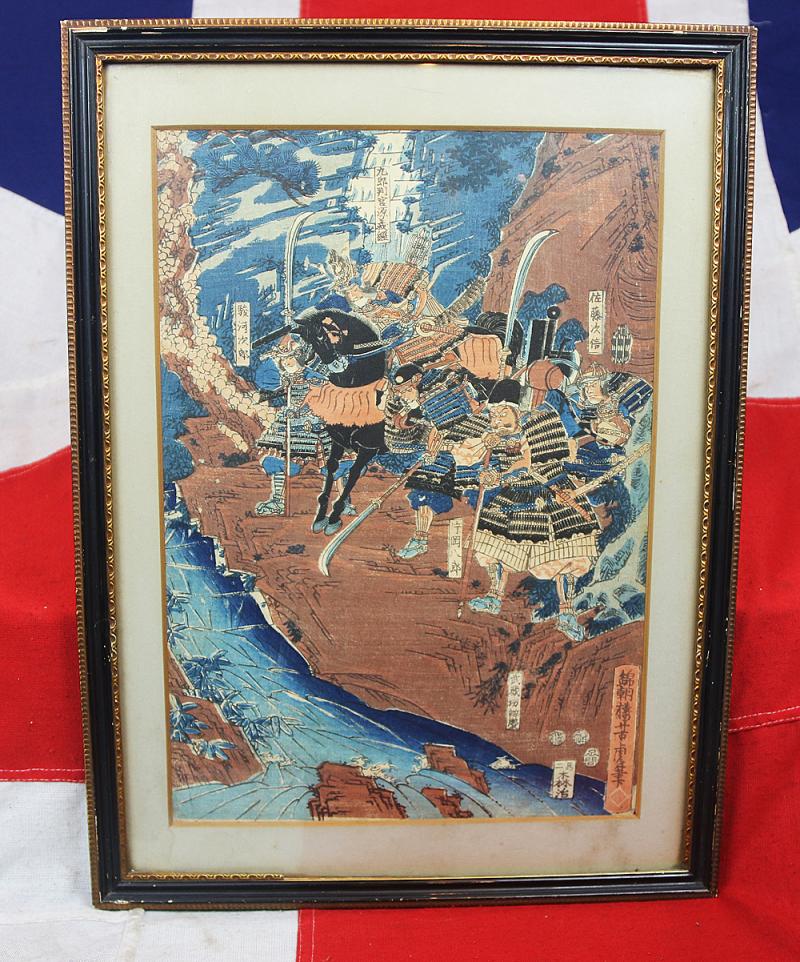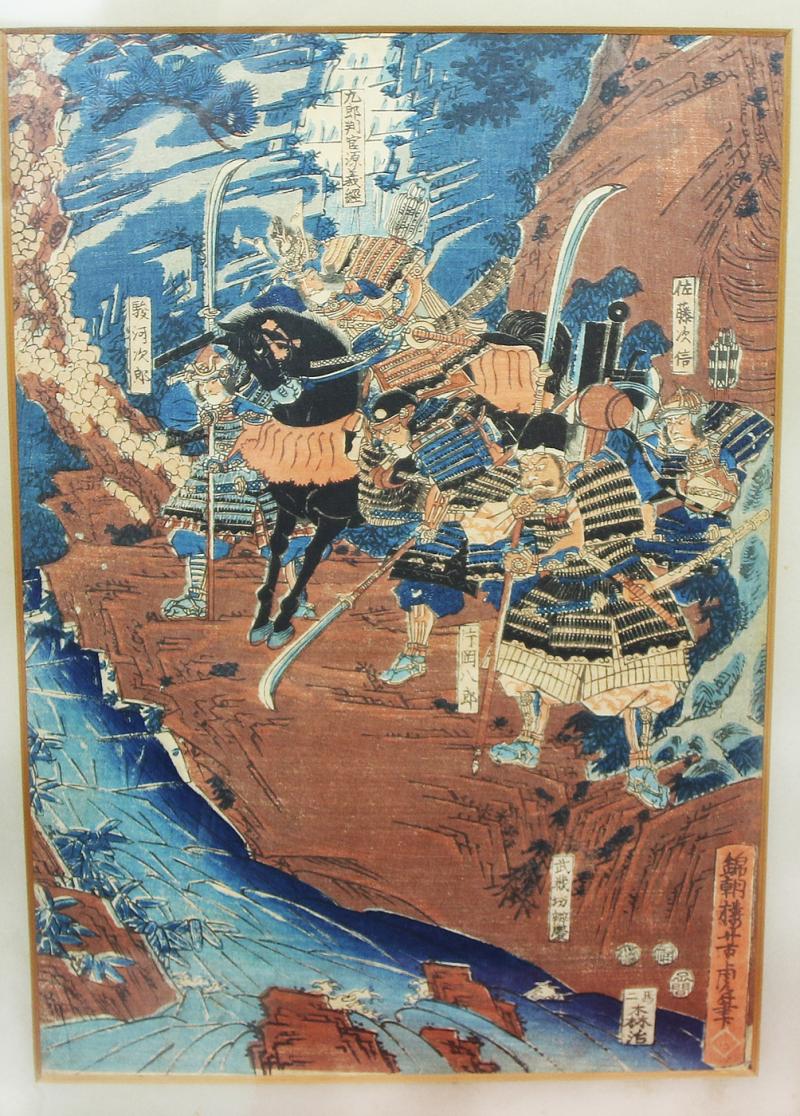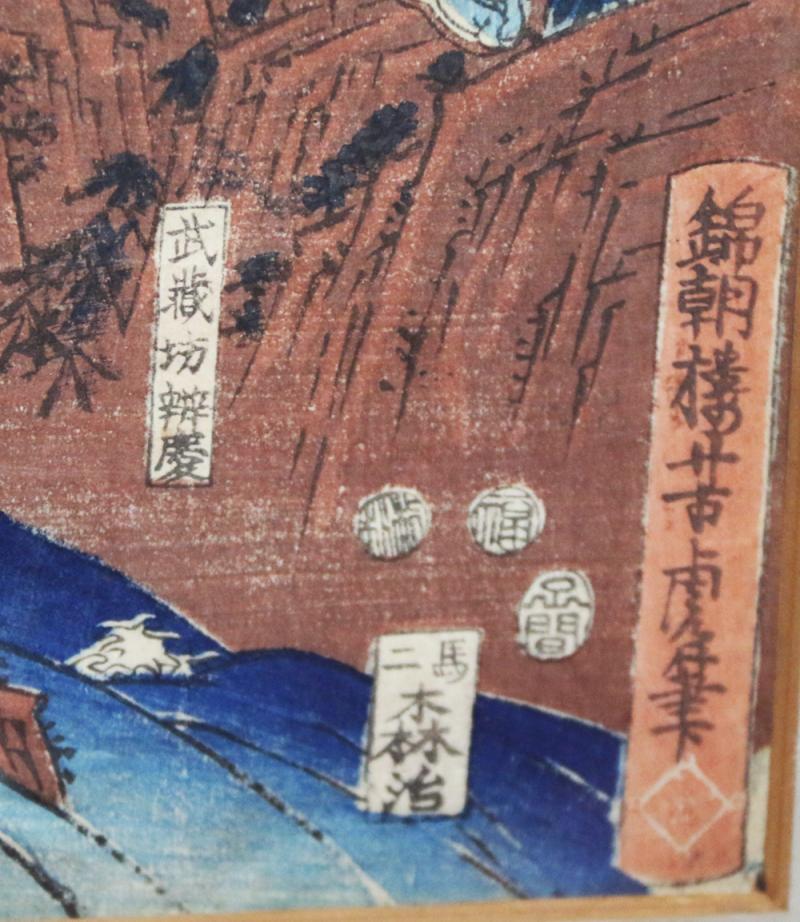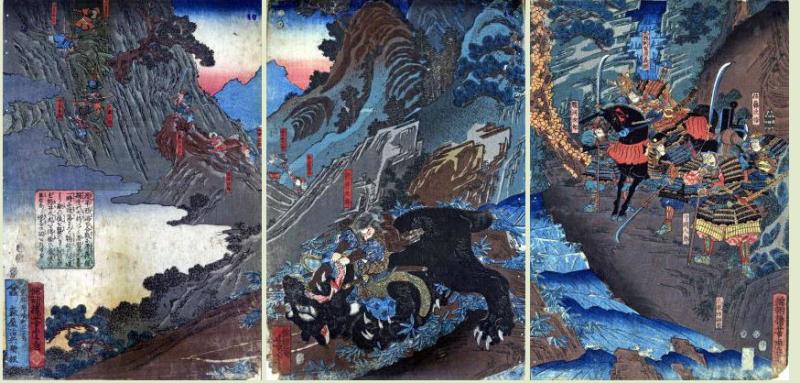A Fine Original Edo Woodblock Print, Signed Yoshitora Utagawa, One of the Most Notable Artists Of Samurai in Edo. Samurai Full Armour By A Riverbank, Titled; Kumai Taro Joins Yoshitsune at Hiyodorigoe Pass Before the Battle of Ichinotani,
In a Victorian Hogarth frame. Overall in very nice condition, and wonderful traditional artistry of samurai warfare. Part of a triptych titled 義経 鵯越にて熊井太郎を得る Yoshitsune Hiyodorigoe nite kumai tarō o eru
translates to; Yoshitsune joins Taro Kumai in Hiyodorigoe
By Yoshitora Utagawa (1836-1880)
The Battle of Ichi-no-Tani (一ノ谷の戦い, Ichi-no-Tani no tatakai) was a battle fought between the offensive Minamoto clan and the defensive Taira clan at Suma, to the west of present-day Kobe, Japan, on 20 March 1184. It sat on a very narrow strip of shore, between mountains on the north, and the sea to the south. This made it quite defensible, but also made it difficult to maneuvre troops inside the fortress. The Taira suffered a crucial defeat to the forces of Minamoto no Yoshitsune and Minamoto no Noriyori.
Minamoto no Yoshitsune split his forces in two. Minamoto no Noriyori's forces attacked the Taira clan at Ikuta Shrine, in the woods a short distance to the east. A second detachment, no more than a hundred horsemen under Yoshitsune, attacked the Taira at Ichi-no-Tani from the mountain ridge to the north. At the chosen hour, the Minamoto forces attacked causing confusion among the Taira who neither deployed nor retreated. Only about 3000 Taira escaped to Yashima, while Tadanori was killed and Shigehira captured. Also killed from the Taira clan were Lord Michimori, Tsunemasa, Atsumori, Moromori, Tomoakira, Tsunetoshi, and Moritoshi.
Ichi-no-Tani is one of the most famous battles of the Genpei War, in large part due to the individual combats that occurred here. Benkei, probably the most famous of all warrior monks, fought alongside Minamoto no Yoshitsune here, and many of the Taira's most important and powerful warriors were present as well.
Ichi-no-Tani is the last recorded instance in which crossbows were used in a Japanese siege.
Yoshitora Utagawa was a woodblock print artist active towards the end of the 19th century in Japan. Born in Edo (today’s Tokyo), neither his date of birth nor date of death is known. Yoshitora was a pupil of Kuniyoshi Utagawa (1798-1861), however, he was expelled due to artistic differences. He went on his own path and changed his artist name to Mosai, producing prints of warriors, kabuki actors, beautiful women, and foreigners in particular (Yokohama-e).
The limited contact with the West imposed by the Japanese regime in the Edo period (1603-1868) created endless curiosity that artists were eager to satisfy, although the situations they imagined were sometimes far from being accurate. It is evident from these prints that the Japanese were fascinated by the clothing, the strange habits and the occupations of the foreigners.
For much of the Edo period Japan adopted a sakoku (closed country) policy. Sakoku was a system in which strict regulations were placed on commerce and foreign relations by the shogunate and certain feudal domains. Trade was limited, except for the port of Nagasaki where the Dutch and Chinese were the only ones allowed to operate. In 1859 the port of Yokohama was opened to foreigners, and ukiyo-e artists, primarily of the Utagawa school, produced hundreds of woodblock print designs in response to a general curiosity about the newly arrived visitors.
Yoshitora was a leading designer of these prints and he also produced a number of landscapes derived from Western engraving. In the Meiji period that began in 1868 he also worked for newly established newspapers.
All three from the triptych would be valued at around £3,000 in Japan, This one is arguably the best of the three containing almost all the samurai warriors..
The complete triptych we show in the gallery
18 inches by 13.25 inches in the frame
Code: 24829





